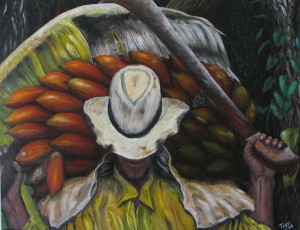 Wolf, Eric. 1969. Peasant Wars of the Twentieth Century. Oklahoma: University of Oklahoma Press.
Wolf, Eric. 1969. Peasant Wars of the Twentieth Century. Oklahoma: University of Oklahoma Press.
Eric Wolf surveys the histories of six different cases of peasant involvement in rebellions and revolutions in the twentieth century. In the final chapter, he draws a series of conclusions from his case studies of revolutions in Mexico, Russia, China, Viet Nam, Algeria, and Cuba. One of the book’s most far-reaching claims is that the middle-peasantry, owners of family-worked smallholdings, is the most potentially revolutionary agrarian sector. The social existence of poor peasants, including landless ones, is far too precarious to engage in risky revolutionary action; though, they will if they are well protected (which assumes that some sort of organized oppositional upheaval is already underway).
Another important factor determining the peasantry’s revolutionary potential, according to Wolf, is their proximity to centers of state control. “In fact, frontier areas quite often show a tendency to rebel against the central authorities, regardless of whether they are inhabited by peasants or not” (293). The geographic location of certain peasantries expanded their “tactical mobility.” The other geographic element in his analysis is that it tries to be multiscalar: “[Peasant-backed revolts] are parochial reactions to major social dislocations, set in motion by overwhelming societal change” (295). In Wolf’s view the peasant revolts are clear instances of Karl Polanyi’s “double movement” in which society throws up protective measures against the ravages of capitalism specifically induced by the commodified forms of land, labor, and capital (277, 282) in which society becomes subordinate to the market.
Another key conclusion in determining peasant involvement is the role played by disaffected (usually middle-class and urban) intellectuals: “In all of our six cases we witness such a fusion between the ‘rootless’ intellectuals and their rural supporters” (289).
One interesting tidbit that caught my eye was the idea of “parallel hierarchies” (48, 188, 203, 243). The first mention comes regarding the Mexican revolution:
In developing a political system of functional associations which crosscut territorial units within one overarching official party, the Mexican political system finally reproduced, under different historical and political circumstances, some aspects of the “parallel hierarchies” which—as we shall see—were to play such an important role in the Chinese and Vietnamese revolutionary movements. (48)
The point is this idea of functional associations that crosscut territorial divisions. This is especially pertinent to the Viet Nam case that describes how territorial divisions of village, district, province were crosscut with socially defined associations (of youth, workers, women, peasants, etc.). An interesting point about “parallel hierarchies” is that they were used by both insurgencies and counterinsurgencies. Coming to terms with the notion that the outcome of irregular wars depends largely on control of the populations, French counterinsurgent officers in Algeria, who “hoped to borrow from Mao, relied on the famous ‘hièrarchies parallèles,’ the combination of organizations based on territoriality with functional organizations” (243).
Some of the more interesting discussions by Wolf revolve around the relations between peasants, parties, and military organizations—and this is an important difference across the case studies, particularly in terms of revolutionaries relation to the state. Peasant insurgents in Russia acted in relative autonomy from the urban-based Soviets. At one point, Wolf cites the accounts of urban Soviet organizers sent to the countryside and they write home as if they were part of an occupation force. With the revolution, peasants resuscitated older forms of rural communal social organization (called mir) generating awkward relations with the Leninist:
The dispersion of the peasant energies in a thousand rural microcosms cleared the political field for final action. Thus the Russian Revolution embraced on the one hand a peasant movement which led centrifugally away from the sources of power, and on the other hand an insurrection of striking workers and mutinous soldiers under Bolshevik leadership which occupied strategic heights of power. (91)
Such tensions turned brutal as in the anarchist movements of Ukraine led by Nestor Makhno. But in Mexico, the inability of the Zapatistas and Villistas to configure a longer-term, institutional apparatus of revolutionary government meant that the more conservative sectors took the lead in the newly formed government. The Cubans on the other hand received no support from the Communist Party until very late in the game, while campesinos also joined late and never really en masse.

Pingback: Antropolog Marxis di Amerika Serikat (2) — ETNOHISTORI